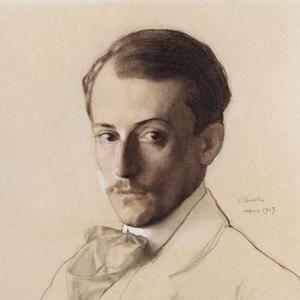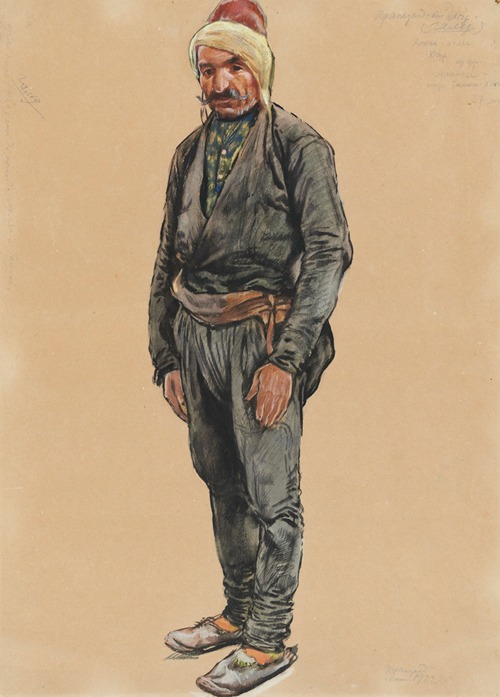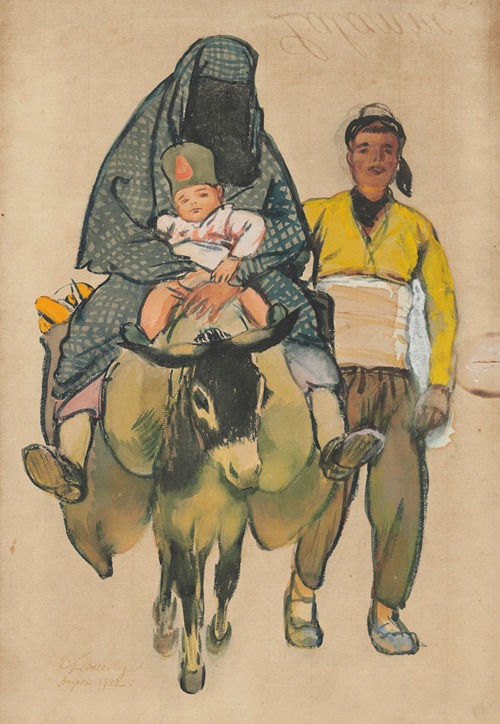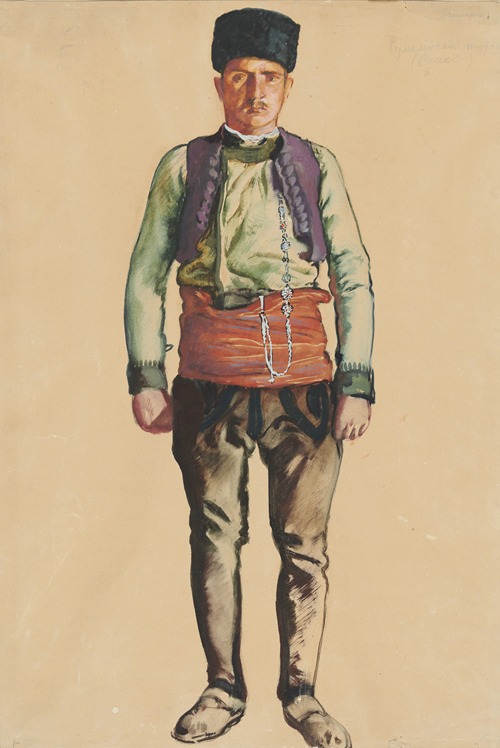

Yevgeny Yevgenyevich Lanceray, also often spelled Eugene Lansere, was a Russian graphic artist, painter, sculptor, mosaicist, and illustrator, associated stylistically with Mir iskusstva ("World of Art").
Lanceray was born in Pavlovsk, Russia, a suburb of Saint Petersburg. He came from a prominent Russian artistic family of French origin. His father, Eugeny Alexandrovich Lanceray, was a sculptor. His grandfather Nicholas Benois, and his uncle Leon Benois, were celebrated architects. Another uncle, Alexandre Benois, was a respected artist, art critic, historian and preservationist. His great-grandfather was Venetian-born Russian composer Catterino Cavos. Lanceray's siblings were also heirs to this artistic tradition. His sister, Zinaida Serebriakova, was a painter, while his brother Nikolay was an architect. His cousin, Nadia Benois, was mother of Peter Ustinov.
His father Eugene Lanceray, who was also an artist, died early, aged forty; when the boy was eleven years old. However, his father's example, memories of everything that was connected with his life and work affected the formation of the personality of the future artist. Already a mature and experienced master, Eugene Lanceray noted that “his search for the right everyday gesture, interest in the ethnographic characterization of characters”, and, finally, “attraction to the Caucasus” were received from his father “as a heredity” characteristic of his work.
The artist spent his childhood in Ukraine, in a small estate of his father Neskuchnoe. After the death of Eugene Lanceray, the artist's father, mother moved with her children to St. Petersburg, to his father's house, known in art circles as “the house of Benois near Nikola Morskoy” (Russian: Дом Бенуа у Николы Морского).
Lanceray took his first lessons at the Drawing School of the Imperial Society for the Encouragement of the Arts in St. Petersburg from 1892 to 1896. under Jan Ciągliński and Ernst Friedrich von Liphart. He then traveled to Paris, where he continued his studies at the Académie Colarossi and Académie Julian between 1896 and 1899.
After returning from France to Russia, Lanceray joined Mir iskusstva, an influential Russian art movement inspired by an artistic journal of the same name, founded in 1899, in Saint Petersburg. Other prominent members of Mir iskusstva' included Lanceray's uncle Alexandre Benois, Konstantin Somov, Walter Nouvel, Léon Bakst, and Dmitry Filosofov.
Like other members of Mir iskusstva, he was fascinated with the "sparkling dust" of Rococo art, and often turned to the 18th-century Russian history and art for inspiration.
Eugene Lanceray was younger than the masters of Mir iskusstva and initially acted as their student. His creative method and aesthetic views evolved under the influence and guidance of Benois, although, by some aspects of his talent, Lanceray may have exceeded his teacher. His first significant works in the field of easel painting and graphics were created in the late 1890 - early 1900s. The main creative interests of the artist were turned at that time to the "historical", mainly architectural landscape.
Lanceray's most celebrated mural painting is located at the ceiling of Moscow Kazansky railway station (1933-1934). Besides its place and its scale, the distinctive feature of this work is that it was made using tempera paint, so beloved by the artist. But he worked with various media, and the area of his activity included not only mural art but also fine art, graphics, illustration and theatrical scenery. For the first time, Lanceray took to the work in the theater in early 1900s, paying tribute to the passion for theater painting, which was characteristic of almost all the representatives of the older generation of the Mir iskusstva group.
Lanceray was the only prominent member of Mir iskusstva to remain in Russia after the Revolution of 1917. Being a representative of traditional painting (not avant-garde movement) and the bourgeoisie, he was not in great demand with the new Soviet government for a long time. Even his sister found the revolutionary milieu alien to her art and, in 1924, she fled to Paris.
Lanceray himself hated the new Soviet regime that he had to exist in after 1917. It referred to his own understanding of the historical way of Russia and the massive oppressions towards his relatives and close friends (some of them immigrated and some of them were killed). In February 1932 he left a note in his diaries: ‘There is incredible impoverishment. Of course, this is the government’s goal to bring everyone and everything to poverty, since it is easier to manage the poor and the hungry’.
Lanceray left Saint Petersburg in 1917, and spent three years living in Dagestan, where he became infatuated with Oriental themes. His interest increased during journeys made in the early 1920s to Japan and Ankara, Turkey. In 1920, he moved to Tiflis, Georgia. During his stay in Georgia, he lectured at the Tbilisi State Academy of Arts (1922–1934) and illustrated the Caucasian novellas of Leo Tolstoy. Amongst his students was Apollon Kutateladze.
Lanceray left Georgia in 1934, settling in Moscow, where he became engaged in the decoration of the Moscow Kazansky railway station and the Hotel Moskva. During the same period, Lanceray also worked as a theatrical designer.
Three years before his death, he was honored with the Stalin Prize, and in 1945 he was awarded the title of People's Artist of the RSFSR. He died in Moscow at the age of 71.


